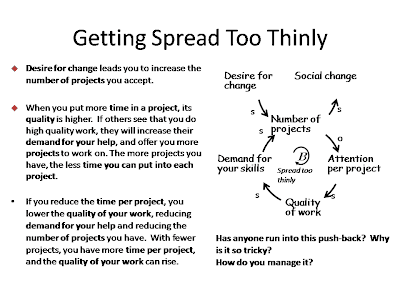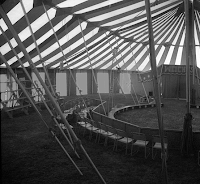(Warning: very long post. You can grab a coffee, or be entirely forgiven for moving on to your daily Dilbert email…)
Thursday as I was going to the airport to catch my flight to New York, I heard an economist on BBC talking about the Madoff Affair and the breaking news about the Satyam chief who disappeared $1b. He and the reporter had a discussion about greed. And the economist said that society now realises that there are limits to economic growth, and that this observation has been influenced by the growing social acceptance over the last few years of the ecological limits that we find ourselves bumping up against from climate change.
Now here’s the part that made me smile, the economist then said that people have a drive towards growth, but that they have to find different ways to better themselves, and not just in economic terms. What music for the rather small group of people that have been humming this tune for years.
Many engaging options for achieving this state of “betterment” have been proffered over the last decade or so. Below I am going to share some of the great ideas and the people behind them that I have heard about. I would also like to add learning something new, or relearning something, to this solutions list. Learning has always been an implicit part of this desired exchange – the trade off between materials goods (or perhaps the feelings of satisfaction/achievement/competition derived from them), for the same feelings derived from non-material activities and their impacts, which are hopefully less costly, less resource intensive, and less polluting.
So, I’m going to champion learning explicitly as an option or an ingredient for obtaining that different feeling of betterment that the economist was talking about. But before that, as I mentioned, people have been working on this. Who’s been on the case?
For years the sustainable development community has not only been talking about limits, a notion initially sparked by the famous book Limits to Growth first published in 1972, but also what society can do differently. These SD practitioners have long promoted replacing material rewards with quality of life rewards, or at least trying it. For example, for the last 5 years, Japan for Sustainability (JfS) and its Chief Executive, Junko Edahiro, has promoted Candle Night on the summer solstice. Candle Night has become a global phenomenon which aims, in a way, to get people to practice an alternative. It’s a “voluntary, participatory, and creative cultural campaign that suggests that people share “alternative ways of spending time” and “more diverse scales of affluence” by temporarily turning away from goods and information as an experience shared by society as a whole.” The campaign creates awareness, dialogue, initiative around these lifestyle alternatives, and JfS is behind it with its deep well of expertise and information when people want to go further.
“More fun and less stuff!” has been a rally cry of the Center for the New American Dream since its founding in 1997. This consumption-focused organization runs effective long-term campaigns including stopping junk mail, parenting in a commercial culture, green procurement, and says about itself, “The Center for a New American Dream is dedicated to helping support and nurture an American dream that upholds the spirit of the traditional dream—but with a new emphasis on sustainability and a celebration of non-material values. We envision a society that values not just “more” but more of what matters.”
Vicki Robin and her partner Joe Dominguez, originally wrote Your Money or Your Life in 1992 to help people “change their lifestyle and transform their relationship with money…” This book has just been re-released in its second edition, and updated “for the 21st century”. Vicki made a lasting impression on me many years ago at a workshop when, just prior to her presentation, she asked the group if they liked how she was dressed. Elegant and colourful, she delighted in telling the group that her entire ensemble cost her just over 3 US dollars, due to clever repurposing, thrift shopping and exchange.
Vicki and her work are backed in part by the Simple Living Network, which provides tools and resources for people who are interested in “conscious, simple, healthy and restorative living.” This links up with the Voluntary Simplicity movement and leaders such as the author Duane Elgin , who wrote “Voluntary Simplicity: Toward a Way of Life that is Outwardly Simple, Inwardly Rich” in 1998. This as you can imagine is a community which goes way back.
For many people today, these are ideas whose time has come. They now fit together more comfortably with the Ebay culture, which is ultimately about repurposing and recycling. And thankfully as people dive further into this there are great resources available, which the people and institutions mentioned here, and many others, have been working to produce and refine for well over a decade. After all, it was in the 1990s that the term “Affluenza” was coined, with its definition including “…the bloated, sluggish and unfulfilled feeling that results from efforts to keep up with the Joneses,” and “…an unsustainable addiction to economic growth.” There are serious messages and there is also humour involved – listen to Stockholm-based sustainability practitioner and writer Alan AtKisson sing his 1997 song, “Whole Lotta Shoppin’ Goin’ On.”
And I think we need to be very careful about messaging. Leisure activities, more quality time spent with families, more consciousness, simplicity, back to basics – all of these things do resonate increasingly with the wider society in this time of economic turmoil. For the last 10 years or so, however, the sustainable development community has dealt with reactions of unpalatability (is that a word?) to their messages, with sustainable development perceived as being about giving up things, or loss of a certain lifestyle. Maybe when the words recession, or depression, are tossed about in the media, doing with less seems more plausible, although I think that most people hope it is a short term thing. I am not sure these changes can afford to be short term, so maybe now is the time to aggressively promote those options, or aspects of these options, that add things of value to people’s lives.
The current financial situation has created a global dialogue around alternatives to economic growth but it has not taken away that very human desire for betterment and progress. Maybe developing more internal, individual metrics of development will help, and learning something new – whether the motivation is re-skilling for a career change, investing in management abilities that keep your team flexible and highly productive, seriously introducing DIY beyond the odd paintjob, or deciding to plant your vegetable patch entirely from seeds (not as easy as it sounds), learning may be both a good option, have good results, and be a good message for many.






























